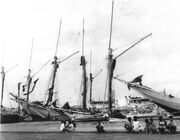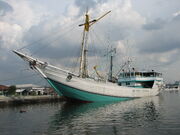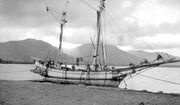
Pinisi boats at the port of Paotere in Makassar, 1994.

Drawing of a Pinisi of Lamba type.

Motorized Lamba Pinisi.

A beached Palari-type Pinisi. Note the shape of the prow.
The pinisi or phinisi is a traditional Indonesian two-masted sailing ship. It was mainly built by the Konjo tribe, a sub-ethnic group of Bugis-Makassar mostly residents at the Bulukumba regency of South Sulawesi but was, and still is used widely by the Buginese and Makassarese, mostly for inter-insular transportation, cargo and fishing purposes within Indonesian archipelago. The pinisi is the largest Bugis traditional vessel, and also the largest Indonesian traditional vessel, after the disappearance of giant jong.
UNESCO designated pinisi boat-building art as a Masterpiece of Oral and Intangible Heritage of Humanity at the 12th Session of the Unique Cultural Heritage Committee on 7 December 2017.
General description[]
The hull of the ships looks similar to that of a dhow while the fore-and-aft rigging recalls western schooners, although it might be more correctly termed to resemble a ketch, as the front mast is the larger.
The large mainsails differ from western style gaff rigs though, as they often do not have a boom and the sail is not lowered with the gaff. Instead it is reefed towards the mast, much like a curtain, thus allowing the gaff to be used as deck crane in the harbour. The lower part of the mast itself may resemble a tripod or is made of two poles.
Pinisi may be 20 to 35 meters long and 350 tons in size. The masts may reach to 30 meters above the deck.
Types of pinisi[]
There are two general types of Pinisi.[1]
- Lamba or lambo. Pinisi of a long and slender built, having a straight stern. This type of Pinisi is the one currently surviving in its motorized version (PLM).
- Palari. Older type of Pinisi with a curved stern and keel. They were usually smaller than the Lamba.
History[]
The first pinisi ships are saidTemplate:By whom to have been built after the example of the Dutch "pinas" (pinnace) introduced to the region by the V.O.C. around 1600. These probably carried lateen or other type of sails, as the modern schooner rig did not become prominent before the 19th century.
Traditional Buginese lontara manuscripts and stories document the use of pinisi by Buginese for transport, as a sailing boat, and a warship.
During the alliance with the Dutch colonialists, pinisis were mainly used as trade ships, transports, and for fishing. Some sources say that at the time of the Indonesian National Awakening pinisi were used by Buginese and people of Sulawesi as warships during the Indonesian struggle for independence.
Design and construction[]

Construction of a pinisi vessel
Several parts of the pinisi are referred to by their original Buginese names, such as: 1. Anjong, (balancing triangle) located at the front deck (Anjungan) 2. Sombala (main sail) the largest sail in the ship 3. Tanpasere (small sail) triangle-shaped, located at each mast 4. Cocoro pantara (front additional sail). 5. Cocoro tangnga (middle additional sail) 6. Tarengke (row additional sail)) 7. etc.
Modern use[]

Pinisi featured in 100-rupiah banknote.
Today, pinisi mainly used for trade, serves as inter-insular cargo, such as to transport timber from Kalimantan to Java, in exchange to transporting grocery and goods from industrialized Java to more remote ports in Indonesian archipelago. Pinisi often frequent traditional ports, such as Sunda Kelapa port in Jakarta, Surabaya, Banjarmasin, and the port of Makassar.
As with many traditional ship types, pinisi have been provided with motors, largely since 1970. This has changed the appearance of the ships. Comparable to modern dhows, the masts have been shortened, or omitted as deck cranes vanished completely, while structures on deck, usually aft, have been enlarged for the crew and passengers.
The pinisi is modified into diving charter boat by foreigner investors for tourism purposes. One such example is that the boat is use as a pitstop for The Amazing Race
See also[]
- Palari
- Bugis in Singapore
- Tongkang
- Borobudur ship
- Schooner
- Pinas (ship)
References[]
- ↑ Michael Kasten: The Indonesian Phinisi
Further reading[]
- G. Adrian Horridge, The Konjo boatbuilders and the Bugis Prahus of south Sulawesi, National Maritime Museum, London 1979.
External links[]
Template:Commons category